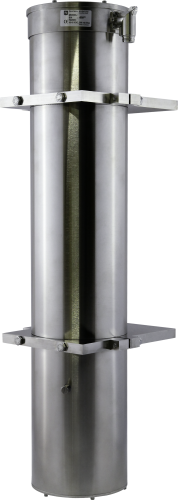This product is no longer available.

| 利用できるサービス |
|---|
概要
The CS725 measures snow-water equivalent (SWE) by passively detecting the change in naturally occurring electromagnetic energy from the ground after it passes through snow cover. It is mounted above the ground and has no contact with the snow. As the snow pack increases, the sensor detects the attenuation of the electromagnetic energy from the ground, and SWE can be calculated. The measurement area of the CS725 is 50 to 100 square meters (540 to 1,075 square feet), making it an excellent replacement sensor for the traditional snow pillow and snow scale.
Common applications for the CS725:
- Hydroelectric power forecasting and hydropower potential forecasting (Read the "Northern Canada: Hydro-electric Power Forecasting" case study.)
- Seasonal run-off management
- Flood forecasting and risk management
- Irrigation planning and management
利点と特徴
- Non-contact measurement
- Excellent replacement for traditional snow-pillow sensors
- Does not cause the melt of light snow
- Greatly reduces the need for site visits
- No site preparation or earthworks required for set-up
- Performance not affected by rainfall or snowfall
- Effective with any type of snow or ice
- Will not cause snow drifting
- Seven-year maintenance cycle
- No antifreeze chemicals used (i.e., glycol)
イメージ





詳細
The CS725 uses an innovative, non-contact method of measuring snow water equivalent (SWE). It passively detects the change in naturally occurring electromagnetic energy (mainly from the decay of 40K) from the ground after it passes through snow cover.
As SWE changes, the amount of energy that penetrates the snow pack changes—regardless of what state of the water (that is, liquid or frozen). A sensor installed above the ground prior to the first snowfall will have a base-line measurement of the electromagnetic energy coming from the ground. As snow accumulates and energy is attenuated, the SWE value will increase. The CS725 has an internal processor that determines the SWE and sends this information to a data logger or communication device via RS-232.
仕様
| Measurement Range | 600 mm maximum water equivalent |
| Accuracy |
|
| Resolution | 1 mm |
| Coverage Angle | 60° |
| Operating Temperature Range | -40° to +40°C |
| Power Requirements | 11 to 15 Vdc |
| Power Consumption | 180 mA |
| Output Options | RS-232 (1200 to 115200 bps) |
| Cable Type | Four conductor, two-twisted pair, 22 AWG, Santoprene jacket |
| Warranty | 2 years |
| Maximum Cable Length | 30 m (98.43 ft) |
| Diameter | 12.7 cm (5 in.) |
| Length | 62 cm (24.4 in.) |
| Main Body Weight | 9 kg (20 lb) |
| Collimator Weight | 25 kg (55 lb) |
| Total Weight | 34 kg (75 lb) |
互換性
注意: 以下は代表的な互換性情報を示しています。互換性のある製品や互換性のない製品をすべて網羅したリストではありません。
互換性に関する追加情報
Collimator Considerations
Other sources of electromagnetic radiation (40K) such as trees, vegetation, and buildings that are not covered by the same amount of snow as the ground can affect the readings. To filter these signals, the optional heavy steel collar (collimator assembly, pn 29390) is installed on the bottom of the CS725.
The following chart outlines when a collimator should be used:
| Site Characteristics | Maximum SWE 300 mm | Maximum SWE 300 to 400 mm | Maximum SWE > 400 mm |
|
Very open site with no proximity to trees, buildings, or tall vegetation within a 48 m (160 ft) radius |
Optional |
Optional |
Optional |
|
No trees, buildings, or tall vegetation within a 24 m (80 ft) radius |
Optional |
Optional |
Required |
|
No trees, buildings, or tall vegetation within a 12 m (40 ft) radius |
Optional |
Required |
Required |
|
Site with minimum clearance radius of 6 m (20 ft) radius |
Required |
Required |
Required |
Note: Always confirm that your sensor has the “Collimator Installed” parameter set properly. The SWE calculations are different for a sensor with and without a collimator.
よくある質問
CS725に関するよくある質問の数: 5
すべて展開すべて折りたたむ
-
The CS725 should be installed prior first snow fall to establish a good baseline reading. However, it can be installed after and the data back-calculated at the end of season. The only problem with this is you won’t have accurate SWE values during the season.
-
Yes, however the data would have to be back-calculated at the end of the season once all snow has melted, you would not have real-time SWE measurements.
-
The sensor takes the measurement and outputs data in RS-232 format. If your data logger can receive RS-232 signals, it should work with the CS725. It’s also best that the data logger can measure volumetric soil moisture.
-
No, at this time the sensor does not output in SDI-12 format; however, it may be added in the future.
-
No, it only measures naturally emitted gamma radiation coming from the ground. The strongest signal of gamma comes from potassium-40 (40K).
ケーススタディ
気候変動は、社会のさまざまな側面に課題をもたらす重要な世界的問題であり、そのため、これらの問題を調査するグループは多面的でなければなりません。ユーコン大学ユーコン研究センター (YRC) が運営する気候変動研究チームは、変化する世界に適応するための教育とソリューションを提供する研究を実施および推進しています。 気候変動研究のウェブサイトをご覧ください。 水力発電はユーコン準州の主なエネルギー源であり、ユーコン準州、マヨ川、アイシヒク川の水文学を研究し、潜在的な発電量を予測する能力は、エネルギー資源の計画強化を可能にします。水力発電が利用できない場合の代替手段は化石燃料の燃焼ですが、これは比較的高価で炭素を大量に排出します。水力発電の計画と管理を支援するために、YRC はユーコン エネルギー コーポレーションと提携しました。この提携により、ブリティッシュ コロンビア州北部、ユーコン準州南部および中央部の主要な河川流域における基礎調査の完了、モデリングおよび予測ツールの開発、遠隔気象観測所の設置が支援されました。 既存のネットワークにおける重要なデータ ギャップは、積雪水量 (SWE) です。春に積雪から放出される水、つまり「春の降水」がダムの主な水源だからです。Campbell Scientific CS725 積雪水量センサーは、非接触方式で SWE を測定するため、この用途に最適です。このセンサーは、地面から自然に発生する電磁エネルギーの減衰を検出することで......続きを読む
システム インテグレーターの Hortus Srl は、イタリア北西部に Campbell Scientific CS725 SWE (積雪水当量) センサーを設置しました。テリノド (トルニョン市) のサイトは海抜 2,100 m......続きを読む
Privacy Policy Update
We've updated our privacy policy. 詳細はこちら
Cookie Consent
Update your cookie preferences. クッキーの設定を更新する

